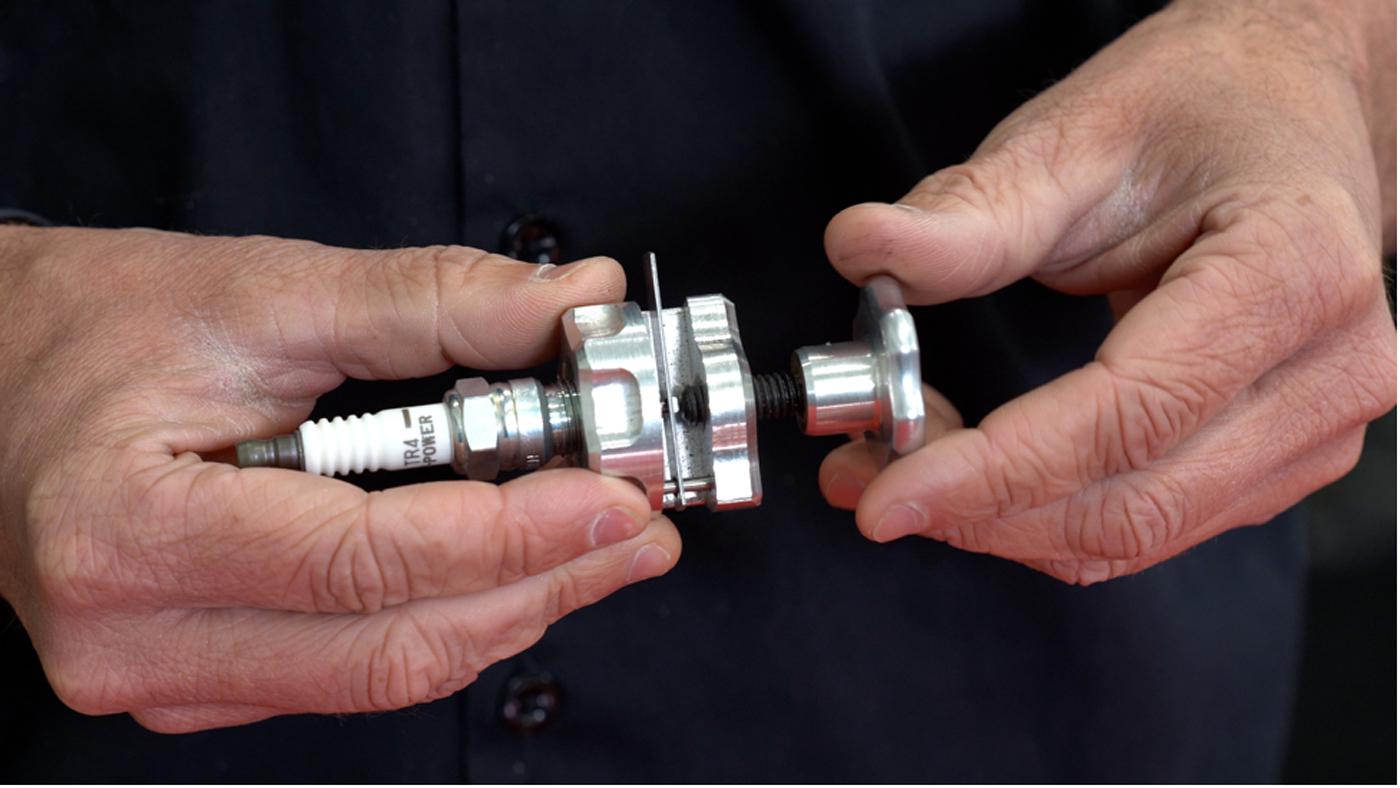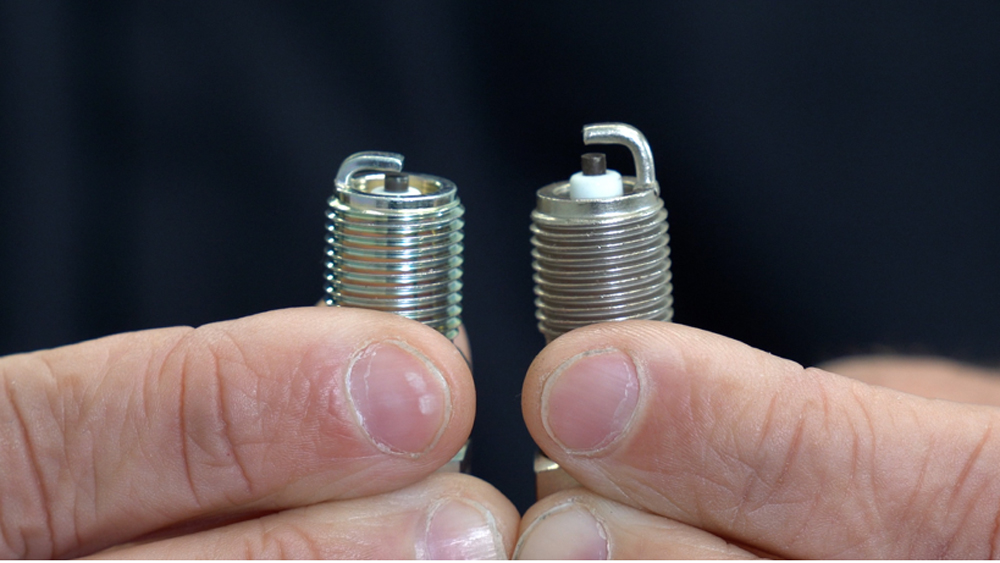PRI Tech: Spark Plugs For Boosted Engines

Forced induction increases pressure in the combustion chamber, so a supercharged engine may need smaller spark-plug gaps to make it easier for the spark to jump from the ground strap to the electrode. This tool pictured at left closes the gap.
Don’t rob your engine of horsepower after adding a mighty supercharger by overlooking those small yet valuable spark plugs.
While spark plugs may not be the most exciting component in a race vehicle’s powertrain, there’s no denying that they can help make horsepower.
On the flip side, they can also cause a race vehicle to lose power if a mistake is made during installation. This is especially true when it comes to engines with power adders, like a supercharger.
What follows are critical spark-plug-related factors to help obtain maximum horsepower gain after boosting a race vehicle.
Heat Range
Heat range is one of the most common things that could (and should) change when adding boost. Most builders are familiar with the requirement of running a colder plug, but they may not understand what it does and why. Let’s break that down first.
The heat range is the spark plug’s ability to pull heat out of the chamber or away from the tip. Pulling that heat away means less chance for detonation, which means more power can be made safely. However, if a plug that’s too cold is installed, it could lead to idle misfires, lack of horsepower, drivability problems, and other problems for race vehicles that typically make 1,000 horsepower or less. For these vehicles, a little bit colder spark plug = good. A lot colder = bad. Boosted drag cars that make 2,000-plus hp, meanwhile, would require a hotter spark plug. If you’re unsure of the proper heat level, check with the spark plug manufacturer.
Plug Gaps
Gap is another key consideration; although, to be clear, we aren’t talking about the gap you’re going to put on your competitor. We’re talking about the gap at the tip of the spark plug. In short, adding boost adds cylinder pressure inside the combustion chamber. When that spark has to jump the gap, it must do so amidst all that extra pressure. To ensure that a spark fires properly every time, you must close the gap to make it easier for the spark to jump from the ground strap to the electrode (assuming coil voltage doesn’t change).
A gap that’s too small might not ignite all the air and fuel mixture. A gap that’s too large could misfire. Check with the spark plug manufacturer or engine builder if you are unsure, but in general, the size we recommend for most street cars making 600–800 hp is about 0.028 to 0.032.
Some cars need a little less gap, like Coyote Mustangs, and higher horsepower engines run an even tighter gap, like 0.018 to 0.022.
Tip Considerations
Spark plug tip styles are not often talked about, considering most engines run standard tips. However, there are lots of different cylinder head options available for a small block Ford or a big block Chevy, and each one has a different spark plug location, depth, and position in the combustion chamber. All of this variability affects how the spark plug tip, either non-projected or projected, sticks out into the air/fuel mixture.

A common misstep is running a non-projected tip plug in a head that requires a projected tip. Even though the heat range is good, and the gap is reduced, the result is often terrible misfires, low horsepower, and an engine that can barely idle. This is because the tip was too far back in the cylinder head. Refer to the cylinder head manufacturer and spark plug manufacturer on the best plug for your application.
Tip Material
Tip material often raises a number of questions. Racers may be concerned, for example, that an iridium or platinum plug will be too hot and might hurt their engine. Rest assured, though, this is not typically the case. Any spark plug material should work well on a supercharged vehicle.
The key difference comes with copper plugs, which will wear faster and must be changed out more frequently. On the other hand, platinum and iridium spark plugs were designed to go much longer without a change, so consider these materials first.
Breakup Problems?
Another topic that must be covered is breakup problems—specifically, resistors in spark plugs. This is rarely discussed, but it is important, nonetheless. Imagine you just installed a supercharger kit, and then you bought and installed new spark plugs from the racing department of your auto parts store. Now your data logger won’t log, your radio sounds off, or you’re experiencing related electrical problems. Chances are you might have bought a spark plug without a resistor. You can’t tell them apart by looking at them, so you need to ask the manufacturer if it has a resistor.
Any modern car with electronic components will require a resistor-style plug. However, an older carbureted vehicle with no electronics can get away with a non-resistor plug. Although it should be noted that there really is no disadvantage to using a resistor plug on these older-model vehicles.
Let’s wrap up with a few useful recommendations:
• First, whenever you change your spark plugs and tug on wires, you risk breaking the connection inside. We recommend replacing the wires regularly to avoid misfires.
• Second, use the tool made for gapping plugs to gently close the gap from the ground strap to the electrode. Spark plugs are generally made of porcelain and copper and have fragile connections, so dropping one on the ground could end up breaking the inside.
• And finally, when in doubt, reach out to your spark plug manufacturer. We’ve always found them to be quite helpful!
Erik Radzins is the Director of Communications and Calibrations for Lenexa, Kansas-based ProCharger, one of the leading aftermarket centrifugal supercharger companies offering power adder options from strip to street. With 20-plus years of experience in the automotive industry, Radzins is an encyclopedia of knowledge on cars and aftermarket enhancements. Also highly skilled at tuning, Radzins leads the ProCharger calibration projects.
 MEMBERSHIP LOGIN
MEMBERSHIP LOGIN JOIN PRI
JOIN PRI


